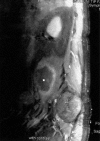Rupture of a nonaneurysmal abdominal aorta due to spondylitis
- PMID: 19436791
- PMCID: PMC2676528
Rupture of a nonaneurysmal abdominal aorta due to spondylitis
Abstract
Contiguous arterial infections are extremely rare, and their actual rate of occurrence is not known. These infections occur as a result of direct invasion of an artery from an adjacent septic focus. Reaching the diagnosis of infected aorta is very difficult when there are contiguous infections from spondylitis or psoas abscess, because the clinical features are nonspecific. Although computed tomography is the most useful diagnostic tool in the detection of aortic infections, the most frequent findings mimic those of other diseases, such as retroperitoneal fibrosis, lymphoma, and periaortic lymphadenopathy. Diagnosis becomes even more challenging when an infected aorta is of normal diameter. Herein, we report the case of a 64-year-old man who experienced nonaneurysmal abdominal aortic rupture due to spondylitis and psoas abscess. Despite appropriate surgical management, the patient later died. We review the relevant medical literature and examine specific considerations that surround the diagnosis and treatment of this rare condition.
Keywords: Aneurysm, infected/diagnosis/etiology/radiography/surgery; aneurysm, ruptured/surgery; aortic aneurysm, abdominal/diagnosis/etiology/surgery; aortic rupture/microbiology/mortality/pathology/surgery; prognosis; spinal diseases/complications; staphylococcal infections/complications/surgery; time factors; treatment outcome.
Figures




References
-
- Mendelowitz DS, Ramstedt R, Yao JS, Bergan JJ. Abdominal aortic salmonellosis. Surgery 1979;85(5):514–9. - PubMed
-
- Sessa C, Farah I, Voirin L, Magne JL, Brion JP, Guidicelli H. Infected aneurysms of the infrarenal abdominal aorta: diagnostic criteria and therapeutic strategy. Ann Vasc Surg 1997; 11(5):453–63. - PubMed
-
- Hsu RB, Tsay YG, Wang SS, Chu SH. Surgical treatment for primary infected aneurysm of the descending thoracic aorta, abdominal aorta, and iliac arteries. J Vasc Surg 2002;36(4): 746–50. - PubMed
-
- Maclennan AC, Doyle DL, Sacks SL. Infectious aortitis due to penicillin-resistant Streptococcus pneumoniae. Ann Vasc Surg 1997;11(5):533–5. - PubMed
-
- Muller BT, Wegener OR, Grabitz K, Pillny M, Thomas L, Sandmann W. Mycotic aneurysms of the thoracic and abdominal aorta and iliac arteries: experience with anatomic and extra-anatomic repair in 33 cases. J Vasc Surg 2001;33(1): 106–13. - PubMed
Publication types
MeSH terms
Substances
LinkOut - more resources
Full Text Sources
Medical
